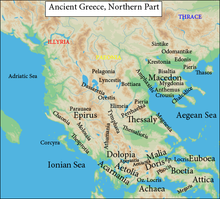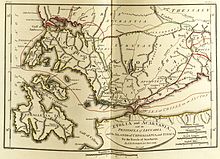Acarnania
Acarnania
Ἀκαρνανία | |
|---|---|
Region | |
Western Greece | |
| Major cities | Stratos |
| Dialects | Doric |
Acarnania (
Acarnania's foundation in Greek mythology was traditionally ascribed to Acarnan, son of Alcmaeon.

History

Pre-Peloponnesian War
The name of Acarnania appears to have been unknown in the earliest times. Homer (8th century BC) only calls the country opposite Ithaca and Cephalonia, under the general name of "Epeirus" (῎ηπειρος), or the mainland, although he frequently mentions the Aetolians.[n 1]
The country is said to have been originally inhabited by the
In the 7th century BC,
The ancient Acarnanians, however, were Greeks, and as such were allowed to contend in the great Pan-Hellenic games, although they were closely connected with their neighbors, the
At an early period, when part of Amphilochia belonged to the Acarnanians, they used to hold a public judicial congress at Olpae, a fortified hill about 3 miles (4.8 km) from Argos Amphilochicum. Of the constitution of their League, we have scarcely any particulars. We learn from an inscription found at Punta, the site of ancient Actium, that there were a council and a general assembly of the people, by which decrees were passed: Ἔδοξε τᾷ βουλᾷ καὶ τῷ κοινῷ τῶν Ἁκαρνάνων. At the head of the League, there was a strategus (Στρατηγός) or general; and the Council had a secretary (γραμματεύς), who appears to have been a person of importance, as in the Achaean and Aetolian Leagues. The chief priest (ἱεραπόλος) of the temple of Apollo at Actium seems to have been a person of high rank; and either his name or that of the strategus was employed for official dates, like that of the first Archon at Athens.
Classical and Hellenistic period

Because it is located strategically on the maritime route to Italy, Acarnania was involved in many wars. Their hatred against the
The Acarnanians were of great service in maintaining the supremacy of Athens in the western part of Greece, and they distinguished themselves particularly in 426 BC, when they gained a signal victory under the command of
After the time of
Roman and Byzantine period
In the 1st century BC, Acarnania suffered greatly at the hands of pirates, and in Roman civil wars. When Greece was reduced to the form of a Roman province, it is doubtful whether Acarnania was annexed to the province of Achaea or of Epirus, but it is mentioned at a later time as part of Epirus. The inhabitants of several of its towns were removed by Augustus to Nicopolis, which he founded after the Battle of Actium, and Acarnania fell under that city's rule; and in the time of Augustus emperor the country is described by Strabo as utterly worn out and exhausted.
In 395, it became part of the Eastern Roman Empire. When the empire was attacked by Western powers in the Fourth Crusade (1204), Acarnania passed to the Despotate of Epirus and in 1348 it was conquered by Serbia. Then in 1480 it fell to the Ottoman Empire. Since 1832 it has been part of Greece.
Modern
Geography
Acarnania is composed of three main regions: 1) a rocky coastline, 2) a rugged strip of mountain range that follows the coastline, and 3) plains lying between these mountains and the Achelous River.
Anciently, Acarnania was reckoned the most westerly province of Greece, bounded on the north by the
There are several promontories on the coast, but of these only two are especially named by writers in antiquity, the promontory of
List of Acarnanians
- Carnus, seer of Apollo who established the cult of Apollo Carneus among the Dorians; see also Carneia.
- Peisistratos (Athens).
- Megistias, seer at the battle of Thermopylae.
- Lysimachus of Acarnania one of the tutors of Alexander the Great
- Philip of Acarnania, one of the physicians of Alexander the Great
- Machatas (sculptor)
- Aristomenes of Acarnania, guardian and regent of Ptolemy V Epiphanes
- Antiochus the Great
See also
- Acarnanian League
- List of cities in ancient Acarnania.
- List of cities in Acarnania
- List of traditional Greek place names
Notes
- ^ In the year 239 BC, the Acarnanians, in the embassy which they sent to Rome to solicit assistance, pleaded that they had taken no part in the expedition against Troy, the ancestor of Rome, being the first time probably, as Thirlwall remarks, that they had ever boasted of the omission of their name from the Homeric catalog. Justin, 28.1; Connop Thirlwall, Hist. of Greece, vol. viii. pp. 119 - 120.
References
- ISBN 0802036430, page 538, "Acarnania on the northern side of the Corinthian gulf was part of Epirus"
- ^ Thuc. 2.102.
- ^ Encyclopedia of ancient Greece
- ^ Thuc. 1.5.
- ^ Thuc. 3.105.
- ^ Xen., Hellenica 4.6; Thuc. 2.80
- ^ Liv. 33.16, 17; Polybius, 28.5.
- ^ Thuc. 3.105 et seq.
- ^ Thuc. 3.114.
- ^ Xen., Hellenica 4.6.
- ^ Livy, 33.16-17.
- ^ Livy, 36.11-12.
- ^ Livy, 45.31.
- ^ Pliny the Elder, N. H, 36.19.
- ^ Pliny the Elder, N. H, 9.56.
Sources
- Hornblower, Simon (1996). "Acarnania". The Oxford Classical Dictionary. Oxford: Oxford University Press. pp. 2–3.
- Chisholm, Hugh, ed. (1911). . Encyclopædia Britannica (11th ed.). Cambridge University Press.
Attribution
![]() This article incorporates text from a publication now in the public domain: Smith, William, ed. (1854–1857). "Acarna'nia". Dictionary of Greek and Roman Geography. London: John Murray.
38°45′N 21°05′E / 38.750°N 21.083°E
This article incorporates text from a publication now in the public domain: Smith, William, ed. (1854–1857). "Acarna'nia". Dictionary of Greek and Roman Geography. London: John Murray.
38°45′N 21°05′E / 38.750°N 21.083°E
External links
![]() Media related to Acarnania at Wikimedia Commons
Media related to Acarnania at Wikimedia Commons
